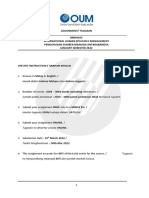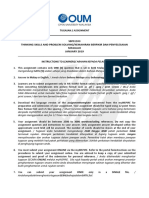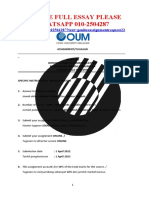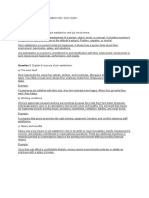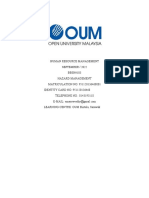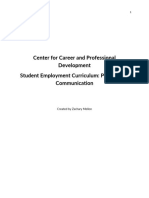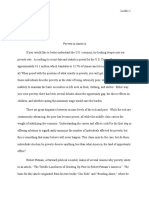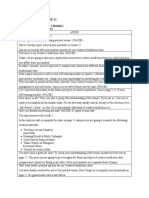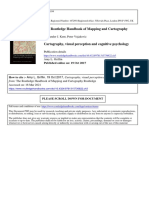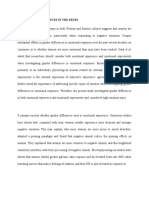OUMH1303
OUMH1303
Uploaded by
Poi ScOriginal Description:
Copyright
Available Formats
Share this document
Did you find this document useful?
Is this content inappropriate?
Report this DocumentCopyright:
Available Formats
OUMH1303
OUMH1303
Uploaded by
Poi ScCopyright:
Available Formats
FACULTY OF EDUCATION AND LANGUAGES Semester 2/ 2011
OUMH1303 ENGLISH FOR ORAL COMMUNICATION
Topic: Communicating Effectively in Spoken English in Selected Social Context
Matric number NRIC Telephone number E-mail address
: : : :
781208135102001 781208 -13-5102 0168854128 poisc0812@ymail.com
Learning Centre
SARAWAK LEARNING CENTRE
OUMH1303 English For Oral Communication
CONTENT
1.0 2.0 INTRODUCTION.2 HOW ORAL COMMUNICATION WORKS.. 3 2.1 2.2 Theories of Oral Communication .3 Transactional Model of Oral Communication ..4
3.0
INTERPERSONAL COMMUNICATION ..5 3.1 3.2 Appropriate Topic of Conversation ..6 Listening and Speaking Skills and Strategies .......7
4.0
SMALL GROUP COMMUNICATION...8 4.1 4.2 4.3 4.4 4.5 Functions of a Small Group Communication ...8 Socials Group, Work Group and Contrived Group.......8 The Advantages of Small Group Communication ... 9 Disadvantage of Small Group Communication.9 The Effective Team or Group Roles10
5.0
PUBLIC COMMUNICATION OR PUBLIC SPEAKING.10 5.1 5.2 Making an Oral Presentation11 Audience Analysis for Effective Communication... 11
6.0
CONCLUSION 12
References
POI SIAW CHEN 781208135102
OUMH1303 English For Oral Communication
1.0
INTRODUCTION
Do you feel strange while talk to strangers or a new friends? People feel afraid that they will give wrong opinions or idea when they communicate with others. The English language has been the most common language of the world for the decades and plays an important role in all aspects of society. Therefore learning and mastering English would greatly give advantage to the person concerned. For the work purposes, speaking English is important in the form of reporting at a departmental meeting, giving board members an overview of a new product or informing a customer of the administrative set up while theres are points why English is importance for study which is to communicate effectively in various situation, to state and justify opinions, to make suggestions and recommendations, to ask for and give clarifications and to conclude a discussion.
As a speaker, one must consider several factors that will provide a better opportunity for them to be heard and understood. Tibodeau (2003) presents six essentials of effective communications which are the message must be delivered in a timely fashion; complete; concise and to the point; factual; accurate; information should be delivered in a clear
message. Becoming a good listener include expansion of knowledge, vocabulary
development and language development, ability to evaluate messages, passing examinations, saving time, accruing financial benefits, and short-cutting acquisition of knowledge (Barker, 1971)
There are several types of communication. This paper will discuss only three types which are interpersonal communication, small group communication and public communication or also known as public speaking. For this paper, we define that communication is a process for transferring information from one to another. The paper also briefly describe about the theory, the principle of the communication among people in different social context.
POI SIAW CHEN 781208135102
OUMH1303 English For Oral Communication
2.0
HOW ORAL COMMUNICATION WORKS
The communication is needed for interpersonal effectiveness comprises of speaking and listening. We are able to express our wants, feelings, thoughts and opinions clearly and effectively; to transmit our thoughts and desires. We must be assertive and put emphasis on our word in a polite way. Oral communication can be both involve listening and speaking skills. Here, we communicate our knowledge and understanding about some particular task given to us. To be good in oral communication, we must be effective in both listening and speaking skills. One essential goal of oral communication is to make personal contact with the audience, and to help connect them to the content.
2.1
THEORIES OF ORAL COMMUNICATION
Communication is the process which increases commonality (Mc quail). According to Newman & Summer, their define communication is an exchange of facts, ideas, opinions, or opinions by two or more persons. It is the exchange of information and transmission of meaning (Katz & Khan) and sharing of experience on the basis of commonness (Wilbur Schramn). Oral communication is a unique and learned rhetorical skill that requires
understanding what to say and how to say it. Unlike conversational speech, speech in more formal environments does not come naturally. What should be learnt is how to critically think about how to present oneself as a speaker in all occasions and then how to function in a variety of speaking environments? Oral communication can take many forms, ranging from informal conversation that occurs spontaneously and, in most cases, for which the content cannot be planned, to participation in meetings, which occurs in a structured environment, usually with a set agenda.
POI SIAW CHEN 781208135102
OUMH1303 English For Oral Communication
Figure1: Communication Cycle Source: http://www-cdr.stanford.edu/ICM/icm.html
2.2
TRANSACTIONAL MODEL OF ORAL COMMUNICATION
The transactional model recognizes that communication is a simultaneous process and therefore switched both the terms sender and receiver to communicator. It also adds environment, which embraces not only physical location, but also personal experiences and cultural backgrounds. These changes can be seen in the model.
Figure 2: The Transactional Model of Communication Source: http://www.communicationstudies.com/ POI SIAW CHEN 781208135102 4
OUMH1303 English For Oral Communication
In this model, it shows that, people can be either a speaker or listener; they can send and receiving messages. The messages that send can be ongoing and changing continuously. The speaker act depends on their background, filed of experiences, their attitudes and their belief. The process look complex because the person involve have to understand the needs, abilities, wants and contribution among them, the speaker have to speaking for others, both them like to finishing the other sentences. Its an interactive face-to-face conversation; there will be noise here and there that can disrupt the transmission. Another change we will notice in the transactional model is the overlap between each communicator. This recognizes similarities between each communicators environments. In addition, the transactional model recognizes how the type of channel can affect meaning. How do the components of this model work together? First, the communicators are simultaneously senders and receivers. Communication is a transaction between two or more people. Then, communication is not only about message sending and receiving, it's also about power and influence like the nature of the relationship is essential to understanding how communication works.
3.0
INTERPERSONAL COMMUNICATION
Interpersonal communication is the communication that done around us, communicate with the several people, which the communication that can be from the impersonal to personal matters; express our feelings, ideas, and thoughts and share them with the people around. In this paper, we discuss about personal and impersonal communication, where the personal communication is an opened communication which is less protected; for the impersonal communication which is the closed communication in interpersonal communication which is more safely, more protected but less connected.
Interpersonal communication differs from other forms of communication in that there are few participants involved, the interaction are in close physical proximity to each other, there are many sensory channels used, and feedback is immediate. Whenever we engage in communication with another person, we seek to gain information about them. POI SIAW CHEN 781208135102 5
OUMH1303 English For Oral Communication
The other reason we engage in interpersonal communication is so that we can gain knowledge about another individual. We gain the information passively, by observing them; actively, by having others engage them; or interactively, by engaging them ourselves. Self-disclosure is often used to get information from another person, its also to help us better understand what someone says in a given context. The words we say can mean very different things depending on how they are said or in what context, to establish an identity. The roles we play in our relationships help us establish identity. So too does the face, the public self-image we present to others. Both roles and face are constructed based on how we interact with others, last but not least, we need to express and receive interpersonal needs.
3.1
Appropriate Topic of Conversation
We should pick topics that everyone involved in the conversation is interested in. That way, everyone can feel comfortable and involved and the conversation should flow freely. The key to any good conversation is to have something that all the people involved can talk about.
a)
Family
Family is usually a good topic to start with. Almost everyone has family that they don't mind talking about. If we do not know the person at all, you could ask whether they've lived in the area long. Instead, bear in mind that conversations should be two way and mention your partner or children.
b)
Occupation
Ask what they do for a living. When they tell us what they do it is another great opener for us to ask questions. If it is an occupation we know something about we can chip in with comments. If it is one we are unfamiliar with, then here is the perfect chance to we learn!
POI SIAW CHEN 781208135102
OUMH1303 English For Oral Communication
c)
Hobbies
Hobbies are a good topic to get on to because they are fun. If they like a sport or hobby that we do too, we are in! We could probably talk for hours on that. Swap stories and try to get an interesting conversation going. These are the types of conversations that are remembered and form the foundations of friendships because they let people know what they have in common with each other.
d)
Vacations
Ask if they have been on vacation recently or if they are planning to go away anywhere. They will just love the chance to tell us about their stories, either good or bad. We do not need to think of anything to say for a while just need to be patient and listen.
3.2
Listening and Speaking Skills and Strategies
In the speaking skills, there are several skills that we can mastered, which is plan what you want to achieve, choose the form your presentation should take, know our own strengths and how much we can handle; do not overstretch ourselves. We also can organize and write the points for the script. We also can design and prepare visual aids and handouts, before we start our presentation, we can rehearse frequently to build up our confidence. Apart from the planning, form, visual aids, language used for communication,
there are several others elements which the speaker should learn to communicate effectively. The Skills are eye contact, body language, style, understanding the audience, adapting to the audience, active and reflexive listening, politeness, precision, conciseness, and so on. As the
speaker, we must be maintain a relaxed posture and be a good listener too because a good speakers are good listeners too.
Listening is an on-going process and a good leader listens effectively. There are basic principles for the listening skills, which are listening with care and listen for the total meaning. Pay attention to verbal and non-verbal clues like tone of voice, pitch, pace and breathing. Next, respond in relevant ways. Look for the speakers intention and POI SIAW CHEN 781208135102 7
OUMH1303 English For Oral Communication
viewpoint and dont immediately answer question based on what we hear. Try to use our own words in verbalizing our understanding of the message. Then, ask questions that require open-ended rather than closed answers. Apart from that, lean into the person. Do not talk until the person stops talking. Lastly, we must be patient because listening takes time and patience.
4.0
SMALL GROUP COMMUNICATIONS
4.1
Functions of a Small Group Communication
Small group communication can be define as a consists of at least three members and at the maximum around twelve to fifteen members; group of peoples that communicate with their members in the group, doing a discussion, assignment, or communication in the workplace. They are given such task or project, and think what they can do. This gives the people that involve in the group a chance to express their idea, to know how far they can give their cooperation and what they can do to make sure their group doing success. Does the member in the group listen to each other? Can they manage the group by communicate with each other? However, for the team to operate smoothly there must be open and efficient communication between the members of the team.
4.2
Socials Group, Work Group and Contrived Group
In the small group communication, the example of social group are families or social clubs which are provide for our safety and solidarity needs and they help us develop selfesteem. Work group plays roles in completing a particular task; example of this work group is workplaces, campus organizations, or juries. They are expertise in their related task. There are several types of work group like additive work group which came from the same field, perform the same activity and the decision is done at the end. For the conjunctive work group, the members is doing different task but related in that field for POI SIAW CHEN 781208135102 8
OUMH1303 English For Oral Communication
completion of a goal. Contrived group or a group of friends, which is performed an organized club, social activities or committees.
4.3
The Advantages of Small Group Communication
Theres an advantage in a small group communication, which is we can get more idea than we are doing some task by ourselves, our idea is recognized by the group members and makes our relationships among member being more closed, the information that they get have needs to be shared to the members. Each member of the team needs to be acquainted with the team goal and his/her role in the team.
The member has specific skills and knowledge that must be utilized and imparted to other members in the course of the work. Any questions or issues about the project must be broached and shared in order to resolve them. Any decisions taken must be imparted to all the members. Effective and open communication lines create feelings of trust and of belonging to the team. The more the members feel valued the more dedicated they are likely to be, and this in turn makes it easier for the team as a whole to achieve its goals.
4.4
Disadvantage of Small Group Communication
Its not that easy to communicate between members, such a small group communication has it lack or disadvantage. For example, the attitude of the members, there such members that very enjoyable when giving their cooperation, but not all of them are doing such; they dont want to share the idea that they have. Some of the members maybe not understand what the group needs and think that they are wasting their time to collaborate in the group. The members may misunderstand one another and develop personal animosities. This can affect their desire to work together and thereby the quality of the POI SIAW CHEN 781208135102 9
OUMH1303 English For Oral Communication
work. The members may not be clear of the sequence of the things to be done and this can either hold up the project or play havoc with the deadlines. The members may not know what to change or how to change to make them more efficient.
4.5
The Effective Team or Group Roles
To improve the effective team communication in such a small group communication, the members have to show some good manner, give a good intention with each other, and be open-minded. Theres some tips that the members can practices, such as make our point clearly in logical manner, ask and give feedback from all the members, ask them whether they understand or not about the task given, make sure all the members in the group have the chance to speak. We have to listen carefully with what they say and dont interrupt when they speak, here we can improve our listening skills.
5.0
PUBLIC COMMUNICATION OR PUBLIC SPEAKING
Public communication or public speaking is the art of speaking to a group of people in a structured manner intended to inform, influence or entertain the audience. The key to good public speaking in terms of voice is, more than anything, being conversational. The best practitioners of public speaking dont sound any different in front of a thousand people. When we speak as ourselves, we sound honest and trustworthy, and not overly self-conscious and nervous. The voice that our listeners in public speaking need to hear is "our" voice. Its one of the most natural and effective aspects of nonverbal communication for public speaking. Great performers in public speaking, in other words, arent born theyre made. Good speakers have simply learned the tips and techniques of best practices in public speaking. And one of the key lessons we help them learn is that they already have just the voice they need to succeed at public speaking.
POI SIAW CHEN 781208135102
10
OUMH1303 English For Oral Communication
The speaker must be prepared with their presentation and keep their messages clear. They have to make the audience feel comfortable by combining the presentation with joke, give a question and the most important is to choose the right word to talk and use the body language for an extra presentation. Public speaking also known as the expressing an idea to many people at the same time. Public communications can centre a small audience or a large crowd, a TV camera or a radio.
5.1
Making an Oral Presentation
An oral presentation consists of three main parts: the introduction, body, and conclusion. The purpose of an introduction is to quickly build rapport with your audience and gain their attention. We want the audience to be able to easily follow thought process as we lead them into the body of the presentation. Next, the main part of the presentation is the body. The body must expound, explain, support, and defend the thesis revealed in the introduction. All main points must be covered. Use examples and illustrations for statements that are difficult for the audience to understand. Graphic illustrations and other visual aids not only help to clarify your message, but also add color and credibility. The presentation should conclude with a well-planned ending which we can use summary, emotional response, recommendations and exit line.
5.2
Audience Analysis for Effective Communication
Audience analysis is a process that shapes the preparation, delivery, and evaluation of any well-thought out speech. It is important to consider audience before, during, and after the act of speaking. Before the speech, analyze the audience more than while we are actually presenting the speech (Grice & Skinner, 2007). The first way to evaluate the audience is characteristics of the audience such as age, gender, ethnicity, education, religion, economic status, and group membership. Besides, we have to evaluate size of the audience also. The number of listeners will often determine how a speaker should POI SIAW CHEN 781208135102 11
OUMH1303 English For Oral Communication
approach a topic (McCarthy & Hatcher, 2002). Large groups demand a structure and set of word choices that convey an acknowledgment of the formality of the occasion; more time to develop credibility and rapport. When speaking to small groups, one can become closer with the audience and interact orally through questions/contributions from individual listeners.
6.0
CONCLUSION
Why communication is important in our daily life? With communication, we can inspires our confident, builds respect in business or workplace and social life, help make friends, develop a distinct personality and reveals our ability to others. We can also organizing our thoughts using body language and being a good listener.
Communicating effectively is not that easy. Without knowledge, self-confident, learning about something, we cant communicate with other people. As we know, in every communication, there must be listening and speaking skills, the communicator have to be spontaneous in expressing their knowledge in such field and has their own level of conversation.
To be effective, you must be a confident speaker, perfect diction, a solid knowledge of the subject matter. The conclusion of effective communication is the product sells; the groups understand the core of the message; you get the job; everyone joins your organization and/or buys the product, a company presentation is accepted. Any positive conclusion is considered effective.
(3068 words)
POI SIAW CHEN 781208135102
12
OUMH1303 English For Oral Communication
References Books Clipson-Boyles, S. (2001) Supporting Language and Literacy 3 8. London: David Fulton Publishers Koh Soo Ling ( 2007 ). Effective Text For Muet. Selangor: Penerbit Ilmu Bakti Sdn. Bhd. S. Sivananachelgi, Chong Poh Wan, Chua Eok Wan, Norazlina Mohamad (2009). English for Oral Communication ( 2nd ed. ). Selangor : Meteor Doc. Sdn. Bhd.
Website Applying Audience Analysis to Public Communication. [Online]. Available: http://homepages.wmich.edu/~cedwards/Teachingmodules/modules/Audience%2 0Analysis.pdf [2011, July 16]
Darrphan Mehta. (2008). 4 Good Topics of Conversation that Get People Talking. [Online]. Available: http://www.sugarmediaz.com/darrpan_main.asp?mpage=tip5.htm [2011, July 6]
David C. Zumbrum. (2006). Effective Communication Skills For Security Personal. [Online]. Available: http://www.ifpo.org/articlebank/Zumbrum_Effective_Communication_Skills.pdf [2011, June 24]
Davis Foulger. (2004). Models of the Communication Process. [Online]. Available: http://davis.foulger.info/research/unifiedModelOfCommunication.htm [2011, June 20]
POI SIAW CHEN 781208135102
13
OUMH1303 English For Oral Communication
France E. Oral Presentation Skills: A Practical Guide. [Online]. Available: http://people.engr.ncsu.edu/txie/publication/oral_presentation_skills.pdf [2011, June 20] M. Mojibur Rahman. (2010). Teaching Oral Communication Skills: A Task-based Approach. [Online]. Available: http://esp-world.info/Articles_27/Paper.pdf [2011, June 24] Sheila Wilkinson. (2009). Strategies for Improving Listening Skills. [Online]. Available: http://www.ehow.com/how_4532218_strategies-improving-listening-skills.html [2011, July 6]
POI SIAW CHEN 781208135102
14
You might also like
- BBPP1103-Principles of ManagementDocument10 pagesBBPP1103-Principles of ManagementSimon RajNo ratings yet
- Oum1303 English For Oral CommunicationDocument13 pagesOum1303 English For Oral CommunicationShawal Hj Md NorNo ratings yet
- Assignment - Bdoe4103Document5 pagesAssignment - Bdoe4103Jahir KorotokNo ratings yet
- Pengurusan Sumber Manusia AntarabangsaDocument8 pagesPengurusan Sumber Manusia AntarabangsaDiyana JamaliNo ratings yet
- Bachelor of Science in Project and Facility Management With Honours MAY 2020Document17 pagesBachelor of Science in Project and Facility Management With Honours MAY 2020Suziah Baindis AngkimNo ratings yet
- SBFS1103Document6 pagesSBFS1103Khatijah Ramli50% (4)
- Abcc1103 F1Document30 pagesAbcc1103 F1Faidz FuadNo ratings yet
- MPU3313 Assignment May 2020Document14 pagesMPU3313 Assignment May 2020AnnieNo ratings yet
- Assignment/ TugasanDocument4 pagesAssignment/ Tugasanapplelind weeNo ratings yet
- OUMM3203 - Vadivookarassi MammaranDocument16 pagesOUMM3203 - Vadivookarassi MammaranVadivookarassi ManimaranNo ratings yet
- How Children Learn Language: The Development of Speech ComprehensionDocument17 pagesHow Children Learn Language: The Development of Speech ComprehensionZeineb Ayachi100% (1)
- Oumh1303 English For Oral CommunicationDocument7 pagesOumh1303 English For Oral CommunicationDsp JimmyNo ratings yet
- Diploma in Early Childhood Education: Matriculation No: Identity Card No.: Telephone No.: E-Mail: Learning CentreDocument8 pagesDiploma in Early Childhood Education: Matriculation No: Identity Card No.: Telephone No.: E-Mail: Learning CentreSherly TanNo ratings yet
- SBFS1103 Thinking Skills Sept15 PadlyalpattaniDocument20 pagesSBFS1103 Thinking Skills Sept15 PadlyalpattaniAseah Othman100% (3)
- SBFS1103Document10 pagesSBFS1103Khatijah Ramli0% (3)
- For The Full Essay Please WHATSAPP 010-2504287:: 1 April 2022Document15 pagesFor The Full Essay Please WHATSAPP 010-2504287:: 1 April 2022Simon RajNo ratings yet
- Bbaw2103 - Financial AccountingDocument13 pagesBbaw2103 - Financial AccountingSimon RajNo ratings yet
- OUMH1303Document10 pagesOUMH1303Lokman SamianNo ratings yet
- Diploma Pendidikan Awal Kanak-Kanak: Diploma in Early Childhood EducationDocument8 pagesDiploma Pendidikan Awal Kanak-Kanak: Diploma in Early Childhood Educationsiti aisyahNo ratings yet
- English For Oral Communication Oumh1303Document9 pagesEnglish For Oral Communication Oumh1303JULIANA BINTI MAT NANYAN STUDENTNo ratings yet
- Bbng3103 International BusinessDocument13 pagesBbng3103 International Businessdicky chongNo ratings yet
- QuestionDocument4 pagesQuestionHaziq ZulkeflyNo ratings yet
- Thinking SkillsDocument17 pagesThinking SkillsnannomansaranghaeNo ratings yet
- Assignment Bdoe4103Document14 pagesAssignment Bdoe4103Shar KhanNo ratings yet
- ASSIGNMENTDocument9 pagesASSIGNMENTamwriterNo ratings yet
- Cel2103 WP Task 1Document3 pagesCel2103 WP Task 1Farahfirzanah TedyNo ratings yet
- Bbsb4103 - Cross Cultural ManagementDocument13 pagesBbsb4103 - Cross Cultural ManagementSimon RajNo ratings yet
- Oumh 2203 AssignmentDocument8 pagesOumh 2203 AssignmentSaroja NathanNo ratings yet
- Abpg1103 - Take Home ExaminationDocument8 pagesAbpg1103 - Take Home ExaminationNurul Syahirah Mohamad AliNo ratings yet
- Mpu3223 - v2 - Entrepreneurship 2Document10 pagesMpu3223 - v2 - Entrepreneurship 2Simon RajNo ratings yet
- Assignment JoesDocument8 pagesAssignment JoesNazmi MatrudinNo ratings yet
- An Overview On Malaysia's Ethics InitiativesDocument6 pagesAn Overview On Malaysia's Ethics InitiativesManivannan M.BNo ratings yet
- Faculty of Science and Technology: Matriculation No: Identity Card No.: Telephone No.: E-Mail: Learning CentreDocument27 pagesFaculty of Science and Technology: Matriculation No: Identity Card No.: Telephone No.: E-Mail: Learning CentreMuhamad MuzakkirNo ratings yet
- BBMC4103 Pengurusan PerubahanDocument6 pagesBBMC4103 Pengurusan PerubahanzabedahibrahimNo ratings yet
- Assignment/Tugasan MPU3313 - V2 Health and Wellness 2 January Semester 2022Document12 pagesAssignment/Tugasan MPU3313 - V2 Health and Wellness 2 January Semester 2022maslianah gudingNo ratings yet
- Health and Wellness 2 - Mpu3313 - V2Document11 pagesHealth and Wellness 2 - Mpu3313 - V2Sri Anish100% (1)
- Bbgo4103 - Organizational BehaviourDocument14 pagesBbgo4103 - Organizational BehaviourSimon RajNo ratings yet
- MGT321 Chapter 4Document3 pagesMGT321 Chapter 4AIZAT ALIFF BIN AZAHARNo ratings yet
- SBFS1103 Thinking Skills and Problem SolvingDocument13 pagesSBFS1103 Thinking Skills and Problem SolvingSimon Raj0% (1)
- Bbpw3103 - Financial Management IDocument13 pagesBbpw3103 - Financial Management ISimon RajNo ratings yet
- Assignment OUMH1203 English For Written Communication January 2021 SemesterDocument6 pagesAssignment OUMH1203 English For Written Communication January 2021 SemesterchuinksiewyenNo ratings yet
- Assigment HUMAN RESOURCE DEVELOPMENT BBDH4103Document10 pagesAssigment HUMAN RESOURCE DEVELOPMENT BBDH4103Loyai BaimNo ratings yet
- Assignment Gelagat OrganisasiDocument19 pagesAssignment Gelagat Organisasiwilliam tangNo ratings yet
- Oumm3203 Professional EthicsDocument10 pagesOumm3203 Professional EthicsSimon RajNo ratings yet
- BBPM2103Document11 pagesBBPM2103Inspire28No ratings yet
- Cbcs4103-Is Audit, Security and ControlDocument9 pagesCbcs4103-Is Audit, Security and ControlSimon RajNo ratings yet
- Principle of MicroeconomicsDocument10 pagesPrinciple of MicroeconomicsDhivaagar ThanarajNo ratings yet
- Smartphone in Millennials: How The Market Can Influence and Being Influenced by Generation YDocument7 pagesSmartphone in Millennials: How The Market Can Influence and Being Influenced by Generation YFrederickChristiantoNo ratings yet
- Soalan Assignment - CBMS4303Document8 pagesSoalan Assignment - CBMS4303aku kacakNo ratings yet
- Community Service AssignmentDocument6 pagesCommunity Service AssignmentSri AnishNo ratings yet
- Oumm2103 - EntrepreneurshipDocument14 pagesOumm2103 - EntrepreneurshipNorzhaahirah Abdullah0% (1)
- Student Handbook Postgraduate Open University Malaysia - 25 March 2019 - V3.00Document64 pagesStudent Handbook Postgraduate Open University Malaysia - 25 March 2019 - V3.00Tutor Evon0% (1)
- BBSH4103 Hazard ManagementDocument9 pagesBBSH4103 Hazard ManagementSweethy Chong Yee MayNo ratings yet
- 20121012102332sample Assignment AnswerDocument19 pages20121012102332sample Assignment AnswerNg Yen Yoong67% (3)
- Assignment Question - ABCR2103Document10 pagesAssignment Question - ABCR2103im jaebumNo ratings yet
- Health and Wellness 2Document3 pagesHealth and Wellness 2Amar Nasir0% (1)
- Bbpm2203 - Marketing Management IIDocument10 pagesBbpm2203 - Marketing Management IISimon RajNo ratings yet
- BBHI4103 Industrial Relation AssignmentsDocument8 pagesBBHI4103 Industrial Relation AssignmentsLing Ching Yap0% (2)
- Bachelor of Management With Honours (BIM)Document7 pagesBachelor of Management With Honours (BIM)Jason Peter Jan PiterNo ratings yet
- ADS 404 Chapter 5Document17 pagesADS 404 Chapter 5Aisyah MohamadNo ratings yet
- Faculty of Education and Language SMP January Intake 2011 Semester 2Document19 pagesFaculty of Education and Language SMP January Intake 2011 Semester 2Kim Yeng Leong100% (1)
- Professional Communication Module PDFDocument25 pagesProfessional Communication Module PDFapi-654101297No ratings yet
- Konsep Gender & Ham Dalam Asuhan KebidananDocument15 pagesKonsep Gender & Ham Dalam Asuhan Kebidanantri yulianiNo ratings yet
- El Español en Los Estados Unidos: Department of Foreign LanguagesDocument6 pagesEl Español en Los Estados Unidos: Department of Foreign LanguagesWilfredo Valentín-MárquezNo ratings yet
- Classified Study File 7 - ProfEd - QuizizzDocument18 pagesClassified Study File 7 - ProfEd - QuizizzPALCULIO JARED PRINCENo ratings yet
- Codedruns 2Document1 pageCodedruns 2dyp8jhppckNo ratings yet
- Lesson Plan - Latin RhythmsDocument4 pagesLesson Plan - Latin Rhythmsapi-368173948No ratings yet
- Art Installation Workshop: Concepting Out of The Box & Meaningful Art InstallationDocument33 pagesArt Installation Workshop: Concepting Out of The Box & Meaningful Art InstallationMuhammad Farhan PristantyoNo ratings yet
- WalshDocument2 pagesWalshShawn RobertsonNo ratings yet
- A Rhythm EticDocument10 pagesA Rhythm EticSchmody Schmafford75% (4)
- Poverty in America Causal - Rough DraftDocument4 pagesPoverty in America Causal - Rough Draftapi-357642398No ratings yet
- CGE14411 - Lecture 13 (Examination and Revision) - 2Document26 pagesCGE14411 - Lecture 13 (Examination and Revision) - 2Po ToNo ratings yet
- SOW ENGLISH YEAR 2 2023-2024 by RozayusAcademyDocument13 pagesSOW ENGLISH YEAR 2 2023-2024 by RozayusAcademyRENA ROZAINI BT MD YUSOF MoeNo ratings yet
- Iris Preparatory SchoolDocument12 pagesIris Preparatory SchooldeboNo ratings yet
- Qualtrics Tei Study PDFDocument27 pagesQualtrics Tei Study PDFcessna5538cNo ratings yet
- Buchanan - Deleuzism A MetacommentaryDocument219 pagesBuchanan - Deleuzism A MetacommentaryShannon Christensen100% (1)
- Podcast Script - Grade 12 Ma. April L. Gueta Creative Nonfiction Quarter 2-Module 1 Second Quarter, SY 2021-2022Document2 pagesPodcast Script - Grade 12 Ma. April L. Gueta Creative Nonfiction Quarter 2-Module 1 Second Quarter, SY 2021-2022LillienneNo ratings yet
- Natalie Resume Di Ms EditedDocument1 pageNatalie Resume Di Ms Editedapi-270994771No ratings yet
- MATURITYDocument14 pagesMATURITYella perezNo ratings yet
- The Routledge Handbook of Mapping and Cartography: Alexander J. Kent, Peter VujakovicDocument12 pagesThe Routledge Handbook of Mapping and Cartography: Alexander J. Kent, Peter Vujakovicmister MrNo ratings yet
- Scope 120117 Cs Mood HL AltDocument2 pagesScope 120117 Cs Mood HL Altapi-428628528No ratings yet
- 3.1: Form Letters and Words in Neat Legible Print Including Cursive Writing. 3.1.1 (A) : Able To Write in Neat Legible Print: (A) WordsDocument2 pages3.1: Form Letters and Words in Neat Legible Print Including Cursive Writing. 3.1.1 (A) : Able To Write in Neat Legible Print: (A) WordsYogeswary DanapalNo ratings yet
- Hacking Knowledge: 77 Ways To Learn Faster, Deeper, and BetterDocument10 pagesHacking Knowledge: 77 Ways To Learn Faster, Deeper, and Betteracbgmp1616No ratings yet
- Emotional Differences in The Sexes 2Document5 pagesEmotional Differences in The Sexes 2Jann ericka JaoNo ratings yet
- NSTP Lesson 1Document22 pagesNSTP Lesson 1Cha PitacioNo ratings yet
- A Five Dimensional Framework For Authentic Assessment PDFDocument21 pagesA Five Dimensional Framework For Authentic Assessment PDFspd bahrilNo ratings yet
- Behaviorism (Also Called Learning Perspective) Is A Philosophy ofDocument20 pagesBehaviorism (Also Called Learning Perspective) Is A Philosophy ofARNOLDNo ratings yet
- Vector LP DONEDocument3 pagesVector LP DONEDave Cercado BugadorNo ratings yet
- Rational For Formative Assessment BookletDocument4 pagesRational For Formative Assessment Bookletapi-311145373No ratings yet
- Cultural AwarenessDocument44 pagesCultural AwarenessMark Andrew Fernandez50% (2)



